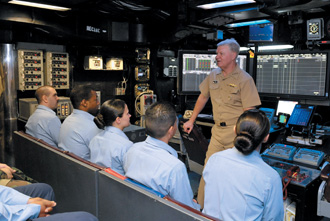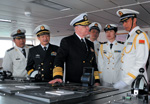An Info-Centric Navy Sets Sail
 |
Adm. Gary Roughead, USN, chief of naval operations (CNO), speaks with sailors in air operations aboard the aircraft carrier USS George Washington. The U.S. Navy is defragmenting its approach to information from its networking architecture down to program and personnel specializations. |
The U.S. Navy is transitioning from network-centric to info-centric as it adjusts for the changing missions of the 21st century. The shift represents less a technology change than an organizational and operational one as the sea service faces more diverse missions with fewer assets.
This does not represent a departure from the network-centric model the Navy pioneered in the 1990s. Rather, it is an evolution from that enabling architecture to the next step in battlespace dominance. It acknowledges that information itself, not its technology architecture or the Navy’s command and control structure, is the key to enabling effective maritime superiority.
Adm. Gary Roughead, USN, chief of naval operations (CNO), offers that the Navy is changing to meet the speed of events that define new types of warfare. Some constants do apply to past and future conflicts. The basic ideas of warfare will continue to dominate—violence and cost to participants. However, the speed and lethality of weapons are increasing in all conflicts, whether conventional or asymmetric.
The admiral adds that the lines of battle will be less clear than they have been traditionally. For example, today’s wars often involve fighting in population centers, and many adversaries show less reluctance to involve noncombatants. Future wars are likely to be less defined and more complex.
The speed of communications and the rapidly changing picture of the battlespace are the main drivers for the Navy’s new info-centric approach. “We will be intertwining information, intelligence and operations in ways that we haven’t done before,” Adm. Roughead declares. This reorganization already is underway, as the CNO is consolidating the N-2 and N-6 offices into a single N-2/N-6 organization.
“This is more than just a wiring diagram change,” he explains. “We’ve also moved programs within the staff that bring the sensors, that bring the networks, that bring the transport systems, that bring the knowledge activities of the Navy—including oceanography and meteorology—into that new organization.” Several unmanned systems also have been brought into the new N-2/N-6 construct, as the admiral offers that they are more dependent on networks than systems with a human in the vehicle. Other programs also have been moved into the new organization.
All of the specialties inherent in those information disciplines have been consolidated into a core that will have “the common bond of information and knowledge,” Adm. Roughead says. These changes all are predicated on the need for speed of information, speed of decision making and superiority of decision making.
“The importance of information and knowledge in the battlespace is such that it no longer can be fragmented among our traditional way of looking at the Navy—in ships, submarines and aircraft,” the admiral declares. “It [information] had to become central to the way that we presented our forces, the way that we could support commanders, and the way that our commanders could be best supported.”
The traditional manner of investment also hindered the flow of information. The Navy’s platform-centric organization led to a fragmented effort, Adm. Roughead offers. He is seeking one view of how all these elements fit together and how the Navy could exploit its information for battlespace domination.
The Navy must be more focused on how information is derived, developed and moved to the right customer at the right time in the right way, the admiral continues. This is the key to providing the Navy with “an information dominance advantage that will be extraordinarily important in the future,” he says.
Adm. Roughead is pleased with the way the Navy’s information modernization is progressing, and he already is beginning to see more ways of ensuring future effectiveness. The new unified approach to information allows the Navy to consider information needs, such as bandwidth, as part of the whole.
However, improvements to the Navy’s afloat information infrastructure largely will have to take place within the existing fleet. More than three-quarters of the current fleet still will be in service by 2020, and upgrades will need to fit within each ship’s existing infrastructure. The way to address bandwidth needs, for example, may lie in greater efficiency.
Antennas may hold the key, Adm. Roughead offers. “We in the Navy can talk about a bandwidth problem, but I don’t believe we cannot say it is not an antenna problem,” he states. Issues such as bandwidth usage may be explored, but antenna solutions also can be helpful—and that is the path the Navy will be taking, he says.
 |
CNO Adm. Gary Roughead, USN, meets with Chinese naval officers as he tours the bridge of a People’s Liberation Army Navy ship in Qingdao, China. The U.S. Navy is extending its global reach as it faces an increasingly diverse set of challenges in the 21st century. |
Already, the Navy has more sailors on the ground in Southwest Asia than it does on ships supporting the wars in
In terms of materiel, the Navy must adjust to hybrid warfare while using the vast majority of its existing assets. However, some changes are appearing in the fleet. Littoral combat ships joining the fleet will be able to operate more capably in littoral areas while also being able to operate with the fleet in blue water. Unmanned systems also are increasing in number and presence. The Fire Scout, the Navy’s first vertical takeoff unmanned aerial vehicle (UAV), has been deployed.
Adm. Roughead emphasizes the growing importance of unmanned systems by citing the rescue mission undertaken by the Navy on behalf of the captain of the cargo ship MV Maersk
The Naval Expeditionary Combat Command has become more routine in its operations and deployment, the admiral adds. Riverine forces, construction battalions, explosive ordnance disposal units and maritime security forces all have a different look. This gives the Navy greater capability and flexibility across the spectrum of conflict, he states.
Shipbuilding will be a major challenge for the Navy, especially with the potential for budgetary constraints. The Navy will need new ships to replace aging vessels, and new missions will increase the demand for new types of ships. However, the Navy does not have the luxury of considering its existing ships legacy equipment, as it will need most of them to form the backbone of the fleet for the foreseeable future.
The future fleet will require a balance of ships to be able to deal with the range of potential conflicts that the Navy might be called on to address. This fleet must have the capacity to meet the needs of combatant commanders, Adm. Roughead states. Capacity currently is the biggest challenge the admiral faces on a daily basis, he offers.
“The numbers that are required out there exceed that which we can provide,” the admiral says. The Navy currently has 285 ships, which is the smallest number in more than 90 years. Based on several analyses, the minimum number the Navy needs is 313 ships, he adds. “What I would like to see—as any chief of any navy would like to see—is more ships. We see the demand, the combatant commanders are demanding them, and I want to provide them.”
He notes that the littoral combat ship is the biggest number driver, and it will be capable of performing many missions. Elsewhere, capability is “in increasing demand” in several areas. One of these is ballistic missile defense, and the Navy has been able to fund that effort to increase the numbers of ships and interceptors. The DDG-51 program, which Adm. Roughead describes as “the ballistic missile workhorse,” is moving toward restart.
The fleet continues to progress in its aircraft carrier program. The newest ship, the USS Gerald R. Ford, is moving forward with its electromagnetic aircraft launching system. Submarine construction continues with two Virginia-class boats each year, and the ballistic missile submarine program is moving toward recapitalization.
Adm. Roughead sounds a cautionary note about the nation’s shipbuilding efforts. He emphasizes that the country’s industrial base is part of U.S. national security, so decisions about the types of ships to be built for the fleet must be based in part on the effects on the industrial base. The admiral describes the shipbuilding base as “rather fragile,” and the health of that base is never far from his thoughts when it comes to planning Navy capabilities. “There has never been a nation that had significant maritime interests that did not have a great navy and a great shipbuilding capability,” he declares.
Today’s challenges are being met, but future challenges concern the CNO. “Are we looking at the future accurately?” he asks. The greatest uncertainty lies in predicting events and where they may unfold, Adm. Roughead offers. Predictions made 10 years ago did not come close to today’s situations. The human element is a prime determinant of how and where conflicts will take place, and that element is not easily foreseen a decade ahead.
“For us, in the Navy, we come as we are,” the CNO points out. “We are deployed, we are forward. You have to make sure you have designed a force that can cover that broadest range of operations and that your people are properly prepared and trained.
“We’ll never have it exactly right, but what we have to be able to do is to put together the capabilities and the systems and the training that prepare our young men and women to cover the range of operations that they’re going to be asked to perform,” he continues. “We have to be able to do it in a way that they never are in a fair fight, that they always have overmatch.”
WEB RESOURCES
Chief of Naval Operations: www.navy.mil/cno/index.asp



Comments